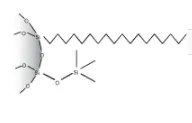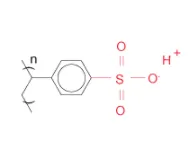Sample Preparation Tip
Level: Intermediate
All My Analytes are Neutrals, but Contaminants are Acids or Amines. What is the Best Way to Concentrate and Clean Up my Analytes of Interest?
Welcome to our new sample prep technical tip. This month we examine how to extract neutral analytes with ionized interferences.
When extracting neutral analytes from an aqueous-based sample matrix (urine, plasma, etc.), it is easy to reach for a reversed phase cartridge (C18, SDBV polymer, etc.). The diagram below depicts a silica-based C18 cartridge which is also end-capped.

The analytes are retained on the C18 chains via Van der Waals interactions. Polar interferences, such as salts, can be washed from the cartridge using water; less polar interferences can be removed using a small percentage of Methanol (typically around 10 %), again in water. Analytes are typically eluted using 100 % Methanol.
There will be occasions where your sample matrix contains acidic or basic impurities that have a relatively high hydrophobicity. Such interferences would be retained at loading, may not be removed during washing, and will probably elute along with your analytes of interest. They may also be found to elute in a similar elution window as your analytes of interest, potentially causing issues with method specificity.

If you make use of a mixed mode cartridge instead of using a “straight reversed phase” cartridge, it is possible to remove the charged interferences during the SPE procedure. If we consider neutral compounds in the presence of a hydrophobic base, the first step would be to acidify the sample to ensure that the basic compound is protonated. This can be achieved by the addition of a strong acid such as Hydrochloric Acid (HCl).
The pH-adjusted sample can then be loaded onto a conditioned and equilibrated cartridge such as Strata™-X-C, shown above. The basic interference will be retained by coulombic attractions on the Sulfonic Acid group shown in red; the analytes of interest by Van der Waals interactions (as seen in a straight reversed phase extraction) through interactions with the rest of the polymer material shown in black.
The wash steps should also contain acid, such as dilute HCl, keeping the pH low. In this case, we would wash with 0.1 M HCl to remove polars, and 0.1 M HCl in 10 % Methanol to remove more hydrophobic impurities. The final elution would then be in Methanol. The hydrophobic base will remain inside the cartridge during the elution step.
A similar approach, using Strata-X-A can be utilized if the removal of acidic compounds is desired. In this case however, rather than using dilute HCl, we would want a buffer around pH 8 for sample adjustment and for using during the wash steps.

We hope this tip was useful! Check out our resources on solid phase extraction and our products highlighted below. See you next month for another tip!

















